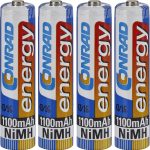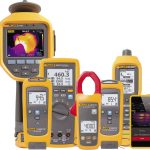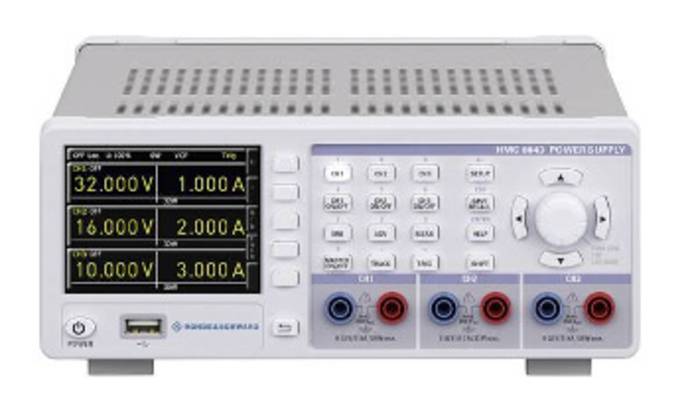Testing & Power supply
Testing & Power Supply
The products from zenith's range of measuring technology and power supplies are used to perform various measurements. These can be force measurements, but also measurements to determine the noise level, to map the radiation in a certain room or simply to determine the temperature in a room.

Accus & Batteries

Battery Chargers

Power Supply Units

Scales

Testers & Meters

Weather measurement devices
Sales Testing & Power Supply
About Measurement &
Power Supply
What was a measuring device?
How do meters work?
Different types of measuring devices
What was to be observed when purchasing measuring devices?
What was power supply?
How do power supplies work?
What types of power supplies are there?
What was to be observed when purchasing power supplies?
Our most popular measurement & power guides
What was a measuring device?
In measuring technology for use in industry and trade, devices are used that measure different physical quantities.
This includes parameters such as electrical current, voltage, resistors or frequencies. Variables such as force, pressure and sound can be measured as well as the temperature of elements and environments. Gases, liquids and electromagnetic fields also capture suitable devices very precisely.
Various measuring instruments are available in the Zenith shop for carrying out these measurements or for displaying and setting values and signals. We distinguish between mobile and stationary measuring devices. Handheld devices are ideal for customer use or changing environments. Stationary measuring devices such as stand-alone devices and devices for connection to the PC are better suited for workshops and laboratories or for longer-term use.
How do meters work?
Measuring instruments use mechanical, optical or electronic sensors to measure the value to be tested either absolutely or against a reference value (setpoint).
In contrast to test equipment, pure measuring instruments such as environmental measuring instruments or multimeters show values that are not interpreted, but require a specialist to assess the inspection. Test and test equipment, on the other hand, sometimes emits optical or acoustic signals when certain measuring ranges are reached or exceeded. The laboratory measuring instruments, which are also part of the measurement technology range, sometimes have not only signal measuring functions but also signal-giving functions, such as function generators.
In Germany, the DIN 1319 standard applies in the field of measurement technology.
Different types of measuring devices
Choose from the Zenith range of high-quality laboratory measuring devices, multimeters, test and testing devices and environmental measuring devices!
Test and test equipment
From 2-pin voltage testers, line meters, earth and insulation meters to speed and vibration meters, you will find test and test equipment for various physical quantities.
There are hardness and material thickness test devices for material measurements and microscopes and endoscope cameras are available for optical inspection.
Test telephones, VDE test devices and other special devices for the professional – with us you will find everything was needed.
Laboratory Equipment
Professional measuring instruments are used in laboratory and workshop environments, which are adapted to the special laboratory conditions. The laboratory measuring devices on the Zenith range include electronic loads, which represent a functional opposite to power sources. In addition, you will find function generators and frequency counters as well as logic analyzers for checking signal curves. Oscilloscopes and spectrum analyzers map signals according to time or frequency ranges.
The laboratory measuring devices available from Zenith are supplemented by USB data acquisition modules and other accessories.
Multimeter
Multimeters always measure current and voltage and the electrical resistance. Some devices in the Zenith range measure frequencies, capacitances of capacitors or additionally test the function of diodes or cables.
In the Zenith range you will find multimeters in the types of hand-held multimeters for mobile use, table multimeters for workshop and laboratory environments as well as clamp-on ammeter multimeters.
We offer multimeters for the following measurement categories:
- Cat I for circuits without connection to the mains
- Cat II for devices on low-voltage networks
- Cat III for measuring building installations
- Cat IV at transfer points to low-voltage installations, such as house connection boxes.
Environmental Testing Equipment
Environmental factors such as temperature, humidity, radiation, sound and pollution are of great importance in measuring technology.
Zenith offers an extensive range of anemometers, humidity and liquid measuring devices as well as devices for measuring gases and pollutant emissions in the area of environmental measuring instruments. Power and pressure measuring devices, devices of temperature measurement technology and those for the determination of electromagnetic quantities (such as electrosmog or radioactivity) can also be found in the shop.
Data loggers are a useful addition to the long-term recording of such measured data and the possibility of subsequent evaluation. They are part of some devices, and can be optionally connected to others.
What was to be observed when purchasing measuring devices?
The most suitable measuring device for your application depends on numerous factors:
Type: Handheld device or stand alone? This is a question of the environment in which they are used. Handheld devices are the right choice if you want to carry out mobile measurements, for example, because they are often on the road with customers. In fixed laboratory or workshop environments or for permanent use, stationary devices can be better suited, especially since they often offer a greater range of functions.
Measuring ranges: Measuring instruments are only good if they are used in a suitable manner. This means that the measuring ranges of the devices must be in the range in which they will also be used. In addition, pay attention to the specified accuracy of the values and whether absolute or reference values for a setpoint are relevant for you.
Accessories: Also make sure that you need additional accessories such as data loggers to use the measuring device or to evaluate or transfer the data. This is usually not the case for stand-alone devices. Interfaces such as connections for USB or memory cards can also be useful.
What was power supply?

In industry, trade and technology, the term power supply is used for all devices that supply connected devices with the necessary energy. It does not matter whether the device must be supplied with a direct voltage or an alternating voltage. It is also irrelevant whether a voltage source is equal to or alternating current.
But not only the voltage adaptation is important for power supplies. Performance adaptation is also a decisive criterion. After all, the power supply must be able to supply the device to be operated with sufficient power. The supply voltage must not break even at full load. On the other hand, an overdimensioned design of the power supply unnecessarily increases acquisition and operating costs.
Depending on the intended use, the power supplies we offer are intended for mobile use, stationary use or fixed installation.
How do power supplies work?
In most cases, a power supply consists of a power supply unit that is connected to the AC voltage of the supply network. The power supply then converts the 230 V AC voltage into a lower DC voltage. To do this, the voltage is first transformed down, rectified and then smoothed with capacitors. Power supplies with an integrated voltage stabilization generate an output voltage at a constant height. Regardless of whether the power supply unit is under maximum load or is operating at idle speed without load.
This is different for voltage supplies that are already operated with a DC voltage. Since a DC voltage cannot be transformed, the power supply must switch the input voltage on and off quickly. This artificial alternating voltage can be transformed very efficiently thanks to the high switching frequency. Depending on the circuit design, a direct voltage of e.g. 12 V can be used to generate a direct voltage of 24 V or even a 230 V alternating voltage.
What types of power supplies are there?
PSUs
Probably the largest group of power supplies are the power supplies. This is not surprising, since many devices or even construction stages within devices and systems cannot be operated directly with 230 V/50 Hz alternating voltage.
In order to be able to offer the right solution for every application, we have power supplies in a wide variety of versions and in a wide range of power classes.
Mains Transformers
Power transformers are not only components of a power supply unit. They can also serve as a power supply alone and without additional external wiring. Such as for the power supply of LED lights for outdoor areas.
In addition to the voltage reduction, galvanic isolation and thus electrical safety are the main features of a transformer. For this reason, special isolating transformers are used for maintenance, service and laboratory. These are just a few examples of the wide range of transformer applications.
AC Regulators & Dimmers
When controlling motors, adjustable power supplies in the form of AC voltage controllers or dimmers provide perfect services.
Thus, electric motors can be continuously controlled in the speed or easily adjusted to the perfect working speed.
Lights and heating plates can also be operated in ideal way. But be careful: Not every AC regulator is suitable for every type of load.
DC DC Converters & Inverters
Making a DC voltage with a lower value is technically quite simple.
It looks different if the output voltage has to be higher or even a 230 V AC voltage with sine-wave form is required.
If a high output power is required, it will be really time-consuming. But here too we have the right solution for every need.
Uninterruptible Power Supplies (UPS)
Contents of Excel tables, Word documents or other application programs are lost in seconds if the power fails. Annoying when the current status has not been saved.
Often a short voltage interruption is enough and the screen contents do not dissolve into anything. With an uninterruptible power supply, there is enough time to store the current data and thus avoid annoying data loss.
generator, aggregates
A power outage that is at most perceived as unpleasant at home can be a disaster for craftsmen and traders.
How good if you can rely on a generator that will keep the main systems running at least.
This makes it easy to avoid the trouble and financial losses caused by loss of work and delays in deadlines.
What was to be observed when purchasing power supplies?
The ideal power supply is easy to find if you take the following points into account or answer the questions.
- The most important criterion is the purpose of use. What is the power supply required for and what was the task? Do ich need a power supply, a voltage converter or an uninterruptible power supply?
- Should the power supply be installed in devices, control cabinets or systems or is an external power supply required?
- What input voltage do ich have and what output voltage is required? Is one output voltage sufficient or are several voltages and different polarities required?
- What is the power consumption of the device to be supplied? The performance of the power supply also depends on the power requirement or the power consumption of the consumer.
- What additional requirements are still to be met? The power supply may have to be splash-proof or redundant.
With this checklist you can find the perfect power supply for you in no time at all.
The must-have for every tool box
But not only in the toolbox of an electrician belongs measuring equipment, but also maintenance staff or installers need the help! Why measuring equipment belongs to your top 10 tools, you can find out in our guide!
Basic equipment for electricians
Tools for caretakers
Tool for installers
Our most popular measurement & power guides
| Guide | Area | |
|---|---|---|
| 1 | Fixed Voltage Mains Adapters | Power supplies |
| 2 | Batteries special sizes | Batteries & Rechargeable Batteries |
| 3 | Weather Stations | Weather#te |
| 4 | Inverters | Power supplies |
| 5 | Rechargeable batteries | Batteries & Rechargeable Batteries |
| 6 | 18650 rechargeable battery | Batteries & Rechargeable Batteries |
| 7 | Lithium-ion rechargeable battery | Batteries & Rechargeable Batteries |
| 8 | Multimeter | Testers & Meters |
| 9 | Power banks | Chargers |
| 10 | Thermo-, Hygro- & Barometers | Meteorological Instruments |
| 11 | Endoscope cameras | Testers & Meters |
| 12 | DC/DC Converters | Power supplies |
| 13 | Voltage tester | Testers & Meters |
| 14 | Geiger Counters & Dosimeters | Testers & Meters |
| 15 | VDE Testers | Testers & Meters |
